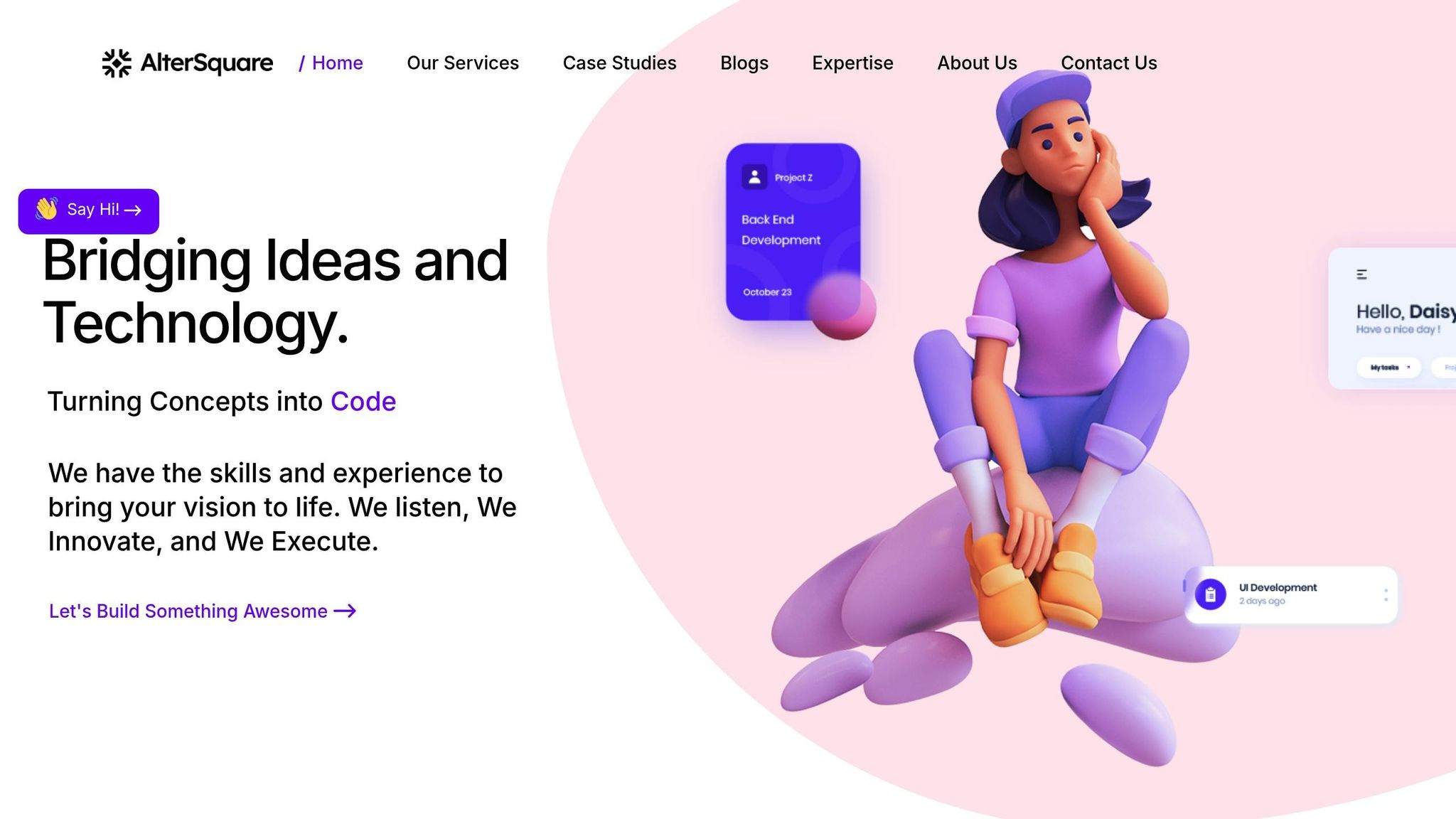Machine Learning for Construction Scheduling: Real Results from 50 Projects
Taher Pardawala September 17, 2025
Machine learning (ML) is transforming construction scheduling by reducing delays, improving resource management, and cutting costs. By analyzing data from 50 projects, this article highlights how ML-driven approaches outperform manual scheduling methods.
Key takeaways:
- Delay reduction: ML predicts potential bottlenecks and adjusts schedules dynamically.
- Resource efficiency: Algorithms optimize workforce, equipment, and material usage.
- Real-time adjustments: Systems respond instantly to changes like weather disruptions or shortages.
- Proven results: Projects using ML saw timelines cut by up to 40% and productivity gains of 20%.
ML tools like supervised learning for delay prediction, unsupervised learning for resource clustering, and reinforcement learning for real-time updates are reshaping how construction teams plan and execute projects. Startups and companies can begin with small-scale pilots, focus on clean data collection, and explore cost-effective outsourcing options like AlterSquare for faster adoption.
The future of construction scheduling is here – will you leverage it to stay ahead?
Revolutionizing Construction Scheduling with AI
Key Machine Learning Techniques for Construction Scheduling
Machine learning (ML) is reshaping construction scheduling by helping predict delays, allocate resources more effectively, and adjust schedules dynamically as projects progress.
Supervised Learning for Delay Prediction
Supervised learning models use historical construction data to predict potential delays in new projects before they even begin. By analyzing past projects and comparing planned timelines with actual outcomes, these models classify projects as either "delayed" or "not delayed." Algorithms like Logistic Regression, Random Forest, and XGBoost are commonly used, with XGBoost often standing out for its accuracy.
For instance, in June 2025, Faruq Lawal developed a machine learning tool for the NYC School Construction Authority. His XGBoost model achieved 71.45% accuracy in predicting construction delays using only planning-stage data, such as the budget, timeline, project type, and phase[1].
"This project combines real-world construction data and machine learning to predict whether a project is likely to face delays. It’s designed with practical use in mind, using only planning-stage inputs like budget, timeline, and project phase." – Faruq Lawal[1]
With this information, project managers can make proactive adjustments to schedules and resources by identifying hidden patterns that might otherwise go unnoticed.
Unsupervised Learning for Resource Management
Unsupervised learning goes beyond delay prediction, helping to streamline resource management by uncovering hidden patterns in construction data. Unlike supervised learning, it doesn’t rely on labeled data, making it ideal for clustering projects with similar traits or identifying anomalies in resource usage.
Clustering algorithms can group projects based on shared characteristics, such as budget size or seasonal start dates, offering insights into how resources can be allocated more efficiently. For example, these algorithms might show that certain types of projects typically require more equipment during specific phases, enabling better planning.
Anomaly detection, on the other hand, flags inefficiencies by identifying irregularities in equipment usage, delays in material deliveries, or subcontractor performance issues. By analyzing data streams like workforce attendance, equipment tracking, and material schedules, unsupervised learning can reveal optimization opportunities that manual analysis might miss. This is particularly helpful for large companies juggling multiple projects, as it can highlight ways to share resources or coordinate deliveries to cut costs.
Reinforcement Learning for Real-Time Adjustments
Reinforcement learning takes construction scheduling to the next level by enabling systems to adapt in real time. Unlike supervised learning, which relies on historical data, reinforcement learning uses trial and error to improve scheduling decisions as a project unfolds.
In this approach, scheduling is treated as a series of decisions, each with potential rewards or penalties. For example, finishing a phase ahead of schedule or reducing equipment downtime earns positive feedback, which helps refine future decisions.
What sets reinforcement learning apart is its ability to react to unexpected events like weather delays, equipment failures, or workforce shortages. When these disruptions occur, the system can immediately adjust schedules, considering both immediate impacts and long-term effects on the project.
As the project progresses, the algorithm continuously learns and improves its strategies, tailoring recommendations to the specific project type, team dynamics, and situational factors. This adaptability also allows it to balance multiple objectives, such as minimizing project duration, cutting costs, optimizing resource use, and maintaining quality. By integrating reinforcement learning with existing project management tools, teams can make informed adjustments using real-time data on progress, resource availability, and external factors like weather forecasts.
Results from 50 Projects: Measured Outcomes
An analysis of 50 construction projects highlights how machine learning (ML) is reshaping operations in the industry. By reducing delays and optimizing schedules, ML has demonstrated its ability to deliver measurable improvements. These findings provide real-world evidence of the techniques discussed earlier, offering a closer look at how timelines and efficiency are being enhanced.
Improved Project Timelines and Fewer Delays
ML has proven effective in cutting delays and reducing project timelines by as much as 40% [2]. Joe Mannon, Director of Scheduling at Manhattan, explains this advantage with a vivid analogy:
"If you see a wreck coming and you have 500 feet instead of 50 feet to stop, you will be in better shape. That’s what SmartPM does." – Joe Mannon [5]
A practical example of this predictive capability came in March 2025, when Buildots introduced its first line of balance project control methods. This AI-powered tool analyzes progress and delay data across multiple activities in a unified view, helping on-site teams pinpoint bottlenecks and make timely adjustments [4]. The result? A smoother workflow and fewer disruptions.
Better Resource Utilization and Efficiency
In addition to speeding up timelines, ML significantly enhances resource management. By improving scheduling, forecasting delays, and enabling predictive maintenance, ML can boost productivity by up to 20% and reduce machine downtime by as much as 50% [3].
A notable advancement occurred in February 2025, when AI Clearing launched a tool designed to generate same-day progress reports for infrastructure and energy projects. This innovation now serves 50% of U.S. solar builders and owners, offering real-time insights into project progress and performance. It underscores the expanding influence of AI in construction management [4].
Rohit Sinha, Chief Technology Officer at SmartPM Technologies, emphasizes the importance of quality data in these systems:
"Analytics are only as good as the data behind them: garbage in equals garbage out." – Rohit Sinha [5]
sbb-itb-51b9a02
Implementation Strategies and Challenges
Bringing machine learning (ML) into construction scheduling requires careful planning, starting with small-scale projects and ensuring seamless data integration. Success hinges on adopting the right strategies and tackling the hurdles that often arise during implementation.
Strategies for Successful ML Integration
Start with a pilot project to test the waters and showcase the potential of ML. Many construction companies begin by focusing on a specific project or a particular scheduling challenge. This phased approach allows teams to familiarize themselves with the technology, understand the data requirements, and demonstrate its value before rolling it out on a larger scale.
Build a strong data infrastructure by standardizing how project information – like progress updates, resource usage, and timeline adjustments – is collected and stored. Consistent, high-quality data is the backbone of accurate ML analytics.
Encourage a culture of ML adoption by involving key team members, such as project managers, superintendents, and field crews, from the outset. When the workforce sees how ML tools can enhance their roles rather than replace them, resistance diminishes, and adoption rates improve.
Provide comprehensive training to ensure that project managers can interpret ML predictions and that field crews understand how their inputs refine the system. A well-trained team that grasps both the technology and the construction processes is key to a smooth implementation.
Once strategies are in place, it’s essential to tackle the common challenges that can hinder ML adoption.
Overcoming Data and Workflow Challenges
Even with the right strategies, data and workflow issues can pose significant obstacles. Incomplete or inconsistent data is one of the biggest barriers to ML success. To address this, companies should establish clear data standards, detailing what information needs to be collected, when it should be recorded, and who is responsible for maintaining its accuracy.
Address resistance to change by emphasizing that ML tools are designed to enhance decision-making, not replace the expertise of managers. Misunderstandings about how ML will impact established workflows often fuel hesitation, so clear communication is vital.
Focus on model interpretability to build trust among team members. Construction professionals need to understand why an ML model predicts delays or suggests schedule changes. Choosing tools that clearly explain the reasoning behind their recommendations can help bridge the gap between technology and human expertise.
Ensure smooth integration with existing systems to avoid creating extra work for teams. This often involves tailoring ML tools to sync seamlessly with current scheduling and resource management platforms.
As ML adoption grows, scalability becomes a critical factor. A system that works well for a single project might falter when applied across multiple, simultaneous projects. Planning for scalability from the start – by designing data systems to handle larger volumes and selecting platforms prepared for enterprise-level deployment – can save time and money down the road.
Treat ML implementation as a step-by-step process. By focusing on building strong foundations, training teams thoroughly, and addressing potential challenges early, construction companies can unlock the full potential of machine learning in scheduling. These deliberate efforts, grounded in real-world project successes, set the stage for enhanced scheduling and resource optimization.
Actionable Steps for Startups and Teams
Drawing from established machine learning (ML) strategies, these steps provide startups with practical ways to implement ML without breaking the bank. Start small, stay focused, and build on a structured process.
Steps to Begin Your ML Journey
Set clear, measurable goals based on your budget and timeline.
Think about what you want to achieve – like cutting delays or improving efficiency – and ensure your objectives align with the resources you have available [8].
Start with a Minimum Viable Product (MVP) targeting one scheduling issue.
Rather than tackling everything at once, focus on solving a single problem. For example, address one pain point to test how well the technology works. This approach helps you show value to stakeholders before scaling up [8].
Focus on high-priority challenges.
Zero in on areas that need the most attention. If delays or resource conflicts are your biggest headaches, start by building models to predict delays or optimize resource allocation [9–11].
Standardize your data collection.
Organize your historical BIM files and schedules into a single, well-maintained folder. Clean, consistent data is the backbone of any successful ML model [6].
Explore and compare available ML tools.
Do your homework. Look into different ML solutions to find ones that fit your needs and can integrate smoothly with your current workflows [8].
Commit to ongoing improvement.
ML is rarely perfect on the first attempt. Be ready to adapt and refine as you gather feedback, learning what works best in your unique construction environment [7].
These steps provide a solid starting point. Once you’ve laid the groundwork, collaborating with experts can help you fast-track your ML implementation.
How AlterSquare Can Accelerate ML Adoption

Developing ML in-house can be expensive and time-consuming. AlterSquare offers a streamlined, expert-driven path to help construction teams adopt ML faster and more efficiently. Their engineering-as-a-service model connects you with AI expertise without the financial burden of hiring full-time staff [12–14].
Quick MVP development.
AlterSquare’s 90-day MVP program delivers rapid prototyping and tech-stack consulting. This lets startups experiment with ML concepts affordably and see results before making larger commitments [12–14].
Access to specialized AI expertise.
With in-depth knowledge of AI, machine learning, and generative AI, AlterSquare designs solutions tailored to the unique challenges of construction scheduling. Their experience ensures your ML systems are built right from the beginning [10].
Seamless integration support.
AlterSquare helps set up data exchange protocols, choose tools compatible with BIM standards, and train your team. Their expertise in handling legacy systems and mismatched software ensures smoother integrations [9].
Cost-effective scaling.
Outsourcing to AlterSquare can slash costs by 30–70% compared to building an in-house team. For example, while in-house development typically costs $132,000–$155,000 annually, outsourced teams cost around $30,800–$36,000. For startups, where 29% fail due to cash flow issues, this kind of savings can be a game-changer [10].
Comprehensive service offerings.
AlterSquare covers everything from backend development and cloud technologies to testing and project management. This all-in-one approach minimizes communication breakdowns, which are a leading cause of project failures [10].
Conclusion: The Potential of ML in Construction Scheduling
With data from fifty projects, it’s clear: machine learning (ML) is making waves in construction scheduling. By accurately predicting delays and optimizing resources, ML is changing how projects are managed.
Encouraged by these results, 76% of construction leaders are increasing their AI investments – a jump of 9%. The AI construction market is also on track to reach $5 billion globally by 2030 [11][12].
Despite being one of the least digitized industries, construction has a unique opportunity to embrace ML solutions that automate tasks and provide predictive insights [11][13]. This creates fertile ground for startups to step in and bring fresh solutions to the table.
For startups, the best approach is to focus on specific ML applications that address immediate issues. These quick wins can help build momentum and gradually expand capabilities over time.
AlterSquare offers a way to overcome traditional ML challenges with their engineering-as-a-service model and 90-day MVP program. This setup allows companies to experiment and innovate quickly – without the need for significant in-house investment.
The future of construction scheduling is being shaped by machine learning. The question is, will your company take the lead? Contact AlterSquare to start your journey toward smarter, more efficient project management.
FAQs
How does machine learning help reduce delays and improve accuracy in construction scheduling?
Machine learning is transforming construction project management by tackling delays and sharpening scheduling precision. By analyzing massive datasets, it identifies patterns, predicts potential risks, and fine-tunes project timelines. This means project managers can foresee delays and adjust plans proactively, leading to smoother operations and smarter resource use.
With advanced algorithms, ML tools accurately estimate task durations and flag risks early in the process. This empowers teams to make well-informed, data-backed decisions, reducing disruptions, cutting down on costly delays, and boosting overall project efficiency.
What challenges do construction companies face when using machine learning for scheduling, and how can they address them?
Construction companies face a few key hurdles when integrating machine learning into their scheduling processes: poor data quality, high upfront costs, and workforce readiness. Let’s break these down.
Data Quality: Machine learning relies heavily on accurate, clean data. When data is messy or incomplete, predictions can miss the mark, leading to unreliable results. To tackle this, companies need to prioritize robust data management practices. This means investing time and resources into cleaning and organizing data before feeding it into machine learning models.
High Costs: The initial investment for machine learning tools can be steep, which might discourage companies from diving in. However, taking a step-by-step approach can ease the financial burden. Start with smaller pilot projects that demonstrate how these tools can boost efficiency and cut costs over time. Once the benefits are clear, scaling up becomes a more manageable decision.
Workforce Readiness: Not every employee will feel prepared – or even willing – to embrace AI-powered tools. Some might lack the technical know-how, while others may be skeptical of the technology itself. Addressing this requires a two-pronged approach: offering focused training to build skills and fostering a workplace culture that views technology as an ally, not a threat.
By tackling these challenges head-on, construction companies can set themselves up to make the most of machine learning, transforming scheduling into a smoother, more efficient process.
How can a construction startup use machine learning for scheduling without a large upfront investment?
Startups looking to incorporate machine learning (ML) into construction scheduling can do so without breaking the bank by leveraging cloud-based AI services. These platforms come equipped with pre-built ML tools, removing the need for expensive infrastructure. This way, teams can concentrate on applying the technology rather than building it from scratch.
Another smart move is partnering with specialized AI vendors or consultants. These professionals can deliver customized solutions and expert guidance, helping startups seamlessly introduce ML into their operations. Focusing on data collection and integration is key – this ensures startups can unlock the full potential of ML while keeping expenses under control.
Related Blog Posts
- How AEC Startups Can Leverage AI for Better Project Estimation
- AI-Powered Estimation: How Machine Learning is Transforming Construction Bidding
- 7 Cloud-Based Tools Revolutionizing Construction Project Management in 2025
- Founders, Stop Overselling AI – Here’s a Realistic 12-Month AI Roadmap for AEC Tools








Leave a Reply